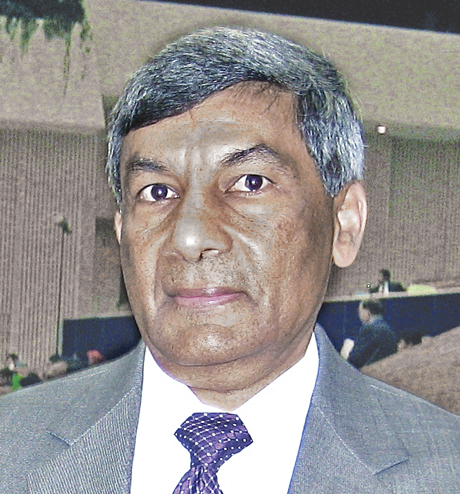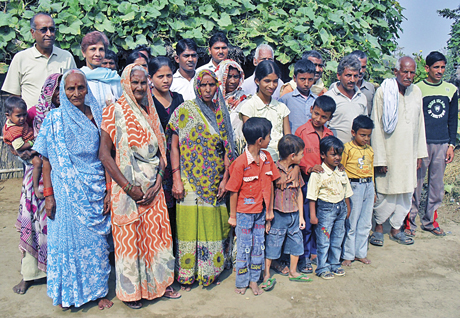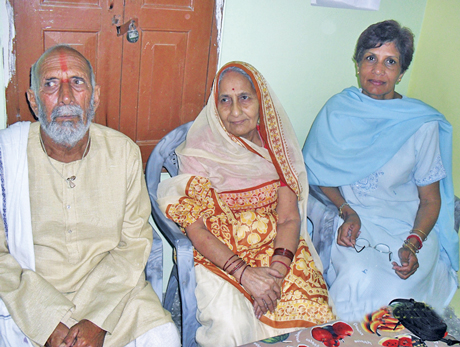Diaspora

By Ashook Ramsaran
My personal quest for my own connection to India was always a yearning long before I met with Minister Jagdish Tytler of the then newly formed Ministry of Overseas Indian Affairs (MOIA) in Brussels, Belgium in October 2004.
My continuing search and inquiries led me through many pathways but nothing definitive that would allow me to pursue a direct link to the ancestral village of my great grandfather Pooriya who arrived in Guyana (then British Guiana) as an Indian indentured laborer in 1853 aboard the ship Adelaide. That information was shown in the single line entry in the birth record of my grandfather Ramlochannd born March 10, 1867 in Guyana. That single line entry also listed my great grandmother Radhah having arrived in Guyana in 1860 aboard ship Colgrain. With no ship records of 1853 or 1860 available in the archives in Guyana, my search moved beyond Guyana to other possible sources such as India and the United Kingdom where I was hopeful that secondary records were kept.
In conjunction with that pursuit, I wanted to become more involved in civic organizations that focused on persons of Indian origin (PIOs) living in various countries. In 1998, I co-founded of the Guyanese East Indian Association (GEICA) which focused on adaptation and assimilation of PIOs from Guyana (and other parts of the Caribbean) in the United States. That same year, I became a life member of the Global Organization of People of Indian Origin (GOPIO International) and shortly thereafter advanced to the position of Secretary General.
From both my vantage point as Secretary General of GOPIO and my regular interaction with other PIOs and non-resident Indians (NRIs) on a global scale, I was able to view the entire global landscape of PIOs and the history of emigration from India during the 19th and 20th centuries. In particular, I acquired historical details, more in-depth knowledge and valuable information on Indian indentured laborers from 1834 through 1920. This appealed to me since I was interested in knowing more about my great grandfather and his journey to Guyana, with the intent that perhaps someday I would be able to find his ancestral village.
After review of my proposal and subsequent discussions, Minister Tytler of MOIA was convinced that my request to initiate and chair a session at PBD2005 was a worthwhile one: I chaired the first “Tracing The Roots” session at Pravasi Bharatiya Divas (PBD) 2005 in Mumbai, India. That session spawned renewed intensity among PIOs and encouraged MOIA to establish “Tracing The Roots” initiatives within MOIA and those were qualified to do actual searches for families in India based on emigration information obtained in the countries of destination. A few Indian states, including Bihar, also initiated programs to assist PIOs to trace their respective families and their ancestral villages.
I considered this a welcome trend that contributed to more interest among descendants of Indian indentured laborers and their quest to connect to their ancestral villages and, in effect, to India itself. It was a very successful session that drew on the experiences of many in PIO countries, historians, academicians and custodians of records of Indian emigration, in particular Indian indentured laborers from 1834 through 1920.
Thereafter, I was emboldened and encouraged to seek more and to do more to fulfill that personal desire to find and connect with the land (even the village) of my ancestors.
Since that time and previous as well, it has been a journey into the unknown, seeking those I have not known but wanting to know. Yet somehow it felt that I may have known them all along but have been missing the connection that could fulfill a long desire that exists as a vacuum. For lack of success in my own quest, that personal quest was quickly transformed to a universal one, representative of the descendants of those who left India from the ports of Kolkata (Calcutta), Chennai (Madras) and Mumbai (Bombay). In so many ways, it was fulfillment of another kind, for the larger good – and how fascinating this journey has been at every single point for me.
While I was standing with Leela Sarup and MOIA officials on the Kidderpore Depot docks on July 7, 2010, that realization came to fruition when the agreement was made with Dr A Didar Singh, Secretary of MOIA, to embark on a two-phase effort to pay tribute to Indian indentured laborers of 19th and 20th centuries (in particular, from 1834 through 1920): Installation of a memorial plaque at Kidderpore Depot (to be unveiled on January 11, 2011) to be followed by a memorial museum and resource center in a suitably significant site in Kolkata. In that respect, the July 7, 2010 meeting was quite historic indeed.
At 3:30pm on 11th January, 2011 at the Kidderpore Depot, 14, Garden Reach in Kolkata, the memorial plaque will be unveiled. It is a long overdue tribute to those who took the risks on barely a promise, to their individual and shared sacrifices and their endurance that made it possible for their descendants to flourish with the spirit of Indianness that transcends time, and to their courage which become a living testament in our lives.
It will truly be a historic moment with enormous significance to millions of descendants of those who left India as indentured Indian laborers during the 19th and 20th centuries. While the unveiling of this memorial plaque will be witnessed by many in person and broadcast live electronically for the PIO world to view, I am convinced that we will not be alone. Also viewing that ceremony will be the souls of those who left those depots, smiling in gratitude and silently shouting “thank you” for remembering and recognizing.
Decades later, we are expressing our gratitude to them and honoring them in visible and significant ways that transcend time.

By Shubha Singh
New Delhi, Dec 12, 2010 — Shobha Rae had two missions when she came to India from Canada - complete a yoga teachers' training course and seek out her relatives for whom she had launched a search four years ago.
For Shobha, Freedom of Information (equivalent to right to information) Administrator for Vancouver City, her first trip to India was a mission of sorts. She wanted to connect with the Indian side of her family with whom she had lost contact.
Shobha's grandfather Vasudeo Rai had gone to the Fiji Islands in 1895. Shobha was born in Fiji but migrated to Canada in the 1970s. She knew that the Rae family had relatives in India; her father, Rajendra Rae had visited the ancestral village, Baijudhia in Gorakhpur district of Uttar Pradesh, over 20 years ago and told his children about his trip.
But India was too distant to think about then, and Shobha and her siblings listened to their father's experiences and forgot about them. In 2004, Shobha began thinking about her connections to India; her interest had been triggered by the launching of the ‘Discover Your Roots Program’ by the International Foundation For Vedic Sciences based in Toronto, Canada.

One needs to provide a copy of the Emigration Pass of the root person that went under the Indenture System and the Foundation sends a researcher in India to search for the family's village in Uttar Pradesh. The researcher located Baijudhia village and sent her the contact details for Banwari Rai, a second cousin.
Prior to this, she had read Dr Rajendra Prasad’s book ‘Tears in Paradise.’ Prasad had spoken about his discovery of the indenture system that took his ancestors to Fiji and his own search for his ancestral village in India at the launch of his book on the subject in Toronto, Canada.
Shobha was deeply moved by the story of indenture. She said, "We were never taught about the Indenture in school in Fiji. In school we read British history, European history, ancient history, but we were never told about the indenture system and how Indians were brought to Fiji and how they were treated. I resolved to find out more about my own family history."
She began by contacting her cousins and other relatives to ask them what they knew about the family history. Finally, a cousin in New Zealand, Nirmala, recalled that she had jotted down some information that Rajendra Rae had given after his trip to India.
There was a phone number for Gorakhpur, and Shobha eagerly dialled the number but found that Ram Naresh Rai (the Indian part of the family spelt their name as Rai) had moved away from the house. That seemed to bring an abrupt end to the search.
Shobha sent Banwari Rai a letter in Hindi and promptly got a reply with an invitation to visit India. She began making plans to visit India and decided to take leave of absence for a month-long yoga training course. She spent over a month at Rishikesh to attend the Yoga Teacher Training course and then made her way to Gorakhpur together with officials of the International Foundation For Vedic Science.
At Baijudhia village, Shobha met a large number of relatives, but she was most gratified to meet Shivmurthi Rai, her father's first cousin - her grandfather's younger brother's son – who lives in Baijanathpur Village.
"I was taken by surprise when I met my grandfather's nephew," Shobha said. "I had not known about him; he is my dad's first cousin. It was an emotional reunion. I was deeply moved at meeting him because I felt that I had a father figure still alive." One of the officials that accompanied Shobha also remarked that some of the family members bore strong resemblance to her.
Shobha was gratified to find that all the relatives had instantly taken her into the family fold. As she sat with the women relatives, Shobha was pleased to find that the women of her Indian family were confident and independent-minded – a trait she recognized in most women in her Indo-Fijian family.
"I was surprised by one of the young girls of the family. She spoke fluent English and told me that she wanted to join the army and go to the National Defense Academy. There was a lively debate among all the women relatives who had gathered there about her joining the army, but she sounded so confident when she spoke about her ambitions."
Shobha exchanged e-mail addresses and phone numbers with her cousins in Baijudhia and Baijanathpur in Gorakhpur District and the extended Rai family - from Canada, India, New Zealand and Fiji - has promised to keep in touch.
(The author, Shubha Singh can be contacted at shubhasingh101@gmail.com)